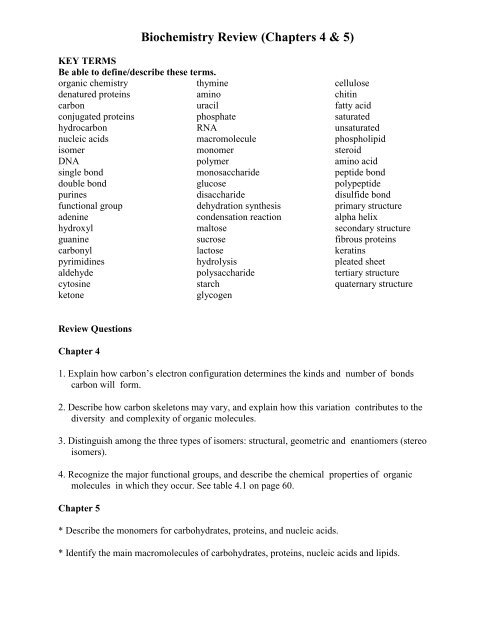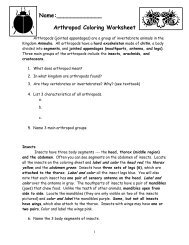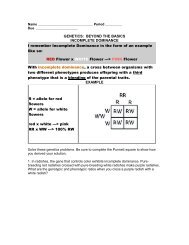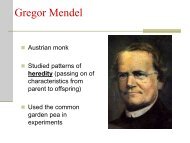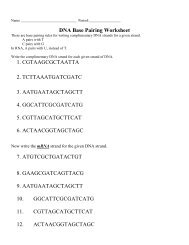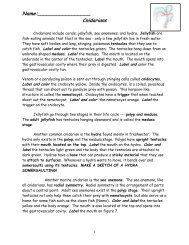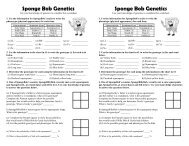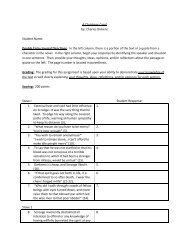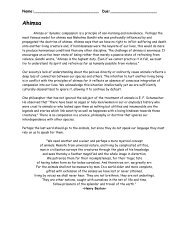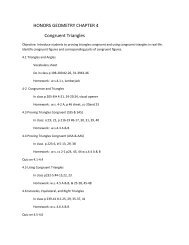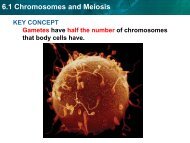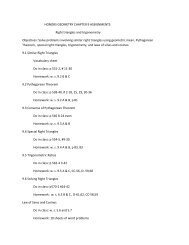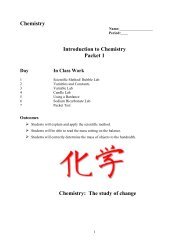Biochemistry Review (Chapters 4 & 5)
Biochemistry Review (Chapters 4 & 5)
Biochemistry Review (Chapters 4 & 5)
You also want an ePaper? Increase the reach of your titles
YUMPU automatically turns print PDFs into web optimized ePapers that Google loves.
<strong>Biochemistry</strong> <strong>Review</strong> (<strong>Chapters</strong> 4 & 5)KEY TERMSBe able to define/describe these terms.organic chemistrythyminedenatured proteinsaminocarbonuracilconjugated proteinsphosphatehydrocarbonRNAnucleic acidsmacromoleculeisomermonomerDNApolymersingle bondmonosaccharidedouble bondglucosepurinesdisaccharidefunctional groupdehydration synthesisadeninecondensation reactionhydroxylmaltoseguaninesucrosecarbonyllactosepyrimidineshydrolysisaldehydepolysaccharidecytosinestarchketoneglycogencellulosechitinfatty acidsaturatedunsaturatedphospholipidsteroidamino acidpeptide bondpolypeptidedisulfide bondprimary structurealpha helixsecondary structurefibrous proteinskeratinspleated sheettertiary structurequaternary structure<strong>Review</strong> QuestionsChapter 41. Explain how carbon’s electron configuration determines the kinds and number of bondscarbon will form.2. Describe how carbon skeletons may vary, and explain how this variation contributes to thediversity and complexity of organic molecules.3. Distinguish among the three types of isomers: structural, geometric and enantiomers (stereoisomers).4. Recognize the major functional groups, and describe the chemical properties of organicmolecules in which they occur. See table 4.1 on page 60.Chapter 5* Describe the monomers for carbohydrates, proteins, and nucleic acids.* Identify the main macromolecules of carbohydrates, proteins, nucleic acids and lipids.
* Recognize the structural formulas for the main macromolecules for carbohydrates, proteins,nucleic acids and lipids.1. List the four major classes of biomolecules.2. Describe the principles relating to formation of macromolecules (polymers) from monomers,and the formation of monomers from polymers. Explain how organic polymers contribute tobiological diversity.3. Describe how covalent linkages are formed (dehydration synthesis, condensation, building upof macromolecules) and broken (hydrolysis, breaking down of macromolecules) in organicpolymers.4. Describe the distinguishing characteristics of carbohydrates, and explain how they areclassified. Describe the monomer for carbohydrates.5. List four characteristics of a sugar.6. Identify a glycosidic linkage and describe how it is formed.7. Describe the important biological functions of polysaccharides.8. Distinguish between the glycosidic linkages found in starch and cellulose, and explain why thedifference is biologically important.9. Explain what distinguishes lipids from other major classes of macromolecules.10. Describe the unique properties, building block molecules and biological importance of thethree important groups of lipids: fats, phospholipids and steroids.11. Identify an ester linkage and describe how it is formed.12. Distinguish between a saturated and unsaturated fat, and list some unique emergentproperties that are a consequence of these structural differences.13. Describe the characteristics that distinguish proteins from the other major classes ofmacromolecules, and explain the biologically important functions of this group.14. List & recognize four major components of an amino acid (the monomer of a protein).Explain how amino acids may be grouped according to the physical and chemical properties ofthe side chains.15. Identify a peptide bond and explain how it is formed.16. Explain what determines protein conformation and why it is important.17. Define primary structure and describe how it may be deduced in the laboratory.
18. Describe the two types of secondary protein structure, and explain the role of hydrogenbonds in maintaining the structure.19. Explain how weak interactions & disulfide bonds contribute to tertiary protein structure.20. Using collagen and hemoglobin as examples, describe quaternary protein structure.21. Define denaturation and explain how proteins may be denatured.22. Describe the characteristics that distinguish nucleic acids from other macromolecules.23. Summarize the functions of nucleic acids.24. List the major components of a nucleotide (the monomer for nucleic acids), and describehow these monomers are linked together to form a nucleic acid.25. Distinguish between a pyrimidine and a purine.26. List the functions of nucleotides.27. Briefly describe the three-dimensional structure of DNA


